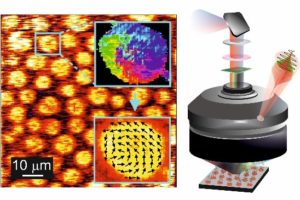
Biological membranes consist of ordered molecular assemblies of various chiral phospholipids, most of which are spatially inhomogeneous. This heterogeneity is expressed by the formation of specialized condensed regions that take on specific functions in biological processes. The physicochemical properties of these lipid islands are substantially governed by the details of in-plane molecular packing structure, which is still largely unknown despite extensive research over several decades. The reason for this shortcoming is related to the lack of appropriate experimental techniques.
In their latest experimental work recently published in Nature Communications, the Nonlinear Interfacial Spectroscopy group present a breakthrough in molecular imaging that allows for unraveling the structural details in such molecular systems. Using a newly developed Sum-Frequency-Generation (SFG) microscope, the authors fully uncover the hierarchical molecular packing structure in condensed domains of mixed phospholipid monolayers. These domains are shown to consist of lipid molecules with spiraling distributions of their in-plane orientations. This spiraling packing structure is found to be dictated by the chirality of the lipid molecule and changes direction upon enantiomeric exchange. Clear breaking in mirror symmetry between the packing structures formed in domains with different enantiomeric mixtures meanwhile reports on enantioselective effects in the formation process. These results underline the importance of enantioselectivity in phospholipid assemblies and give important insights into the long-standing question of why evolution drove towards homochiral membranes.